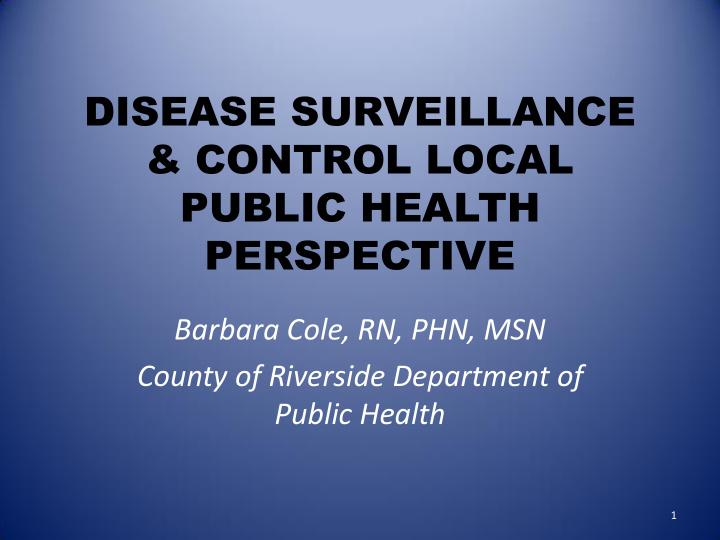



DISEASE SURVEILLANCE & CONTROL LOCAL PUBLIC HEALTH PERSPECTIVE Barbara Cole, RN, PHN, MSN County of Riverside Department of Public Health 1
I MPORTANCE OF P UBLIC H EALTH I NFRASTRUCTURE AT THE L OCAL L EVEL • Essential to maintain the capacity to prepare and respond to public health threats at the local level. • Adequate staff with training and expertise is the foundation of communicable disease prevention and control. 2
I MPORTANCE OF P UBLIC H EALTH I NFRASTRUCTURE AT THE L OCAL L EVEL ( CONT .) • California Health & Safety mandates that public health maintain programs to protect the public’s health. – Tuberculosis – Immunizations – STD/HIV – General Communicable Diseases 3
D ISEASE S URVEILLANCE AT THE L OCAL L EVEL • Control of communicable diseases is based on epidemiology; the study of the distribution, causes, and transmission of communicable diseases within the population. • Must have the ability to conduct active as well as passive surveillance. • Must have access to public lab services which are an essential part of diagnosis of diseases and identifying potential threats in our community. 4
M ULTIPLE R EPORTABLE D ISEASES AND C ONDITIONS 5
C HALLENGES F ACING L OCAL P UBLIC H EALTH D EPARTMENTS • Diminishing local resources. – A recent survey by the California Association of Communicable Disease Controllers (CACDC) indicated that 73% of responding local health departments (LHDs) indicated budget and/or staffing reductions impacted their ability to carry out CD control activities. 6
C HALLENGES F ACING L OCAL P UBLIC H EALTH D EPARTMENTS ( CONT .) • Delayed response times. • Increased follow-up by telephone rather than home visits. • More difficult to conduct active surveillance. • Lack of CD specific funding for local health departments. 7
E MERGING AND R E - EMERGING I NFECTIOUS D ISEASES • Norovirus Outbreaks in long term care and correctional facilities. • Pertussis (Whooping cough outbreaks). 8
E MERGING AND R E - EMERGING I NFECTIOUS D ISEASES ( CONT .) • Pertussis (Whooping cough outbreaks) (cont.) 9
10
N OVEL I NFLUENZA • H1N1 Influenza Outbreak in 2009 – Challenged local health department’s ability to conduct disease investigations. Implement control measures including mass vaccination clinics. – Local health department’s readiness to respond to the next Novel Influenza Outbreak is crucial for protecting the public’s health. 11
T HREAT P OSED BY M EASLES • Immunizations are an excellent example of primary prevention. • Significant reduction in measles morbidity and mortality. • One case has the potential to trigger a major outbreak. • LHDs must have resources to quickly investigate reported cases, conduct contact tracing, implement quarantine measures when indicated, and maintain surveillance for secondary cases. 12
13
A PPLICATION OF E PIDEMIOLOGICAL P RINCIPLES • Epidemiological principles facilitate disease investigation and outbreak containment. • Identifying the likely causative agent. • Steps include: – Developing a case definition and implementing a plan of action. 14
A PPLICATION OF E PIDEMIOLOGICAL P RINCIPLES ( CONT .) – Evaluating the effectiveness of the intervention. – LHDs must have adequate and knowledgeable public health staff to carry out the mandated responsibilities to protect our communities. 15
D ECAY OF THE P UBLIC H EALTH I NFRASTRUCTURE • “In 1988, Institute of Medicine described the current public health system as inadequate to protect the public health through effective, organized and sustained efforts.” • How will the public health system be described in the next five years and beyond? • Will we be able to carry out our mandate to protect the public’s health? 16
T HANK Y OU ! 17
Recommend
More recommend